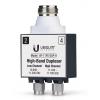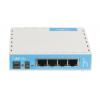-
€
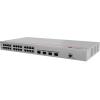
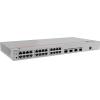

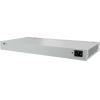
El S310-24T4S de Huawei es un switch gestionado de la serie eKitEngine. Está equipado con 24 puertos Gigabit Ethernet (10/100/1000 Mbps) y 4 ranuras SFP (1 Gbps). Ofrece gestión de Layer 2 y funciones básicas de Layer 3 y es compatible con los protocolos Spanning Tree (STP / RSTP / MSTP) y el moderno estándar ERPS (Ethernet Ring Protection Switching). Dispone de una función Smart Link que permite crear una conexión de reserva. Puede conectar la serie S310 a varios switches de agregación mediante varias conexiones, garantizando así el funcionamiento de la red en caso de que se dañe uno de los cables. El producto ofrecido se distingue por sus avanzadas funciones de seguridad, está protegido contra varios tipos de ataques (incluidos DoS, IP/MAC spoofing o SYN flood), utiliza DHCP Snooping y recuerda las entradas ARP, lo que protege contra el ARP spoofing. Una ventaja adicional es la compatibilidad con iStack: varios switches pueden apilarse virtualmente en un único dispositivo. La gestión se realiza a través de Web UI, CLI o SNMP. El dispositivo es compatible con la gestión en la nube y la aplicación eKit. El switch cuenta con una fuente de alimentación de AC integrada y refrigeración activa con ajuste inteligente de la velocidad del ventilador. El S310-24T4S está diseñado para su uso como switch principal (core) en redes basadas en soluciones eKitEngine. Gracias a su amplia gestión y a sus numerosas capacidades, también demostrará su valía en otras aplicaciones, no sólo en combinación con puntos de acceso.
La nueva versión de firmware (R24 o posterior) reduce significativamente el tiempo de arranque, mejora la gestión del funcionamiento de los ventiladores y mejora considerablemente el control a través de la interfaz de usuario web. Permite la configuración de la mayoría de los parámetros a través de la interfaz gráfica, mientras que antes muchas funciones sólo eran accesibles a través de la CLI.
Le recomendamos que actualice sus dispositivos a la versión R24. Puede obtener el firmware a través de nuestro equipo de asistencia en support@cdr.pl.24 puertos Gigabit Ethernet, 4 ranuras SFP
El switch está equipado con 24 puertos Gigabit Ethernet (10/100/1000 Mbps) y cuatro ranuras SFP (1 Gbps). La capacidad de conmutación es de 56 Gbps y la velocidad de reenvío de paquetes es de 42 Mp/s. Con una de las ranuras SFP, puede crear una conexión incluso a distancias muy largas utilizando un cable de fibra óptica.
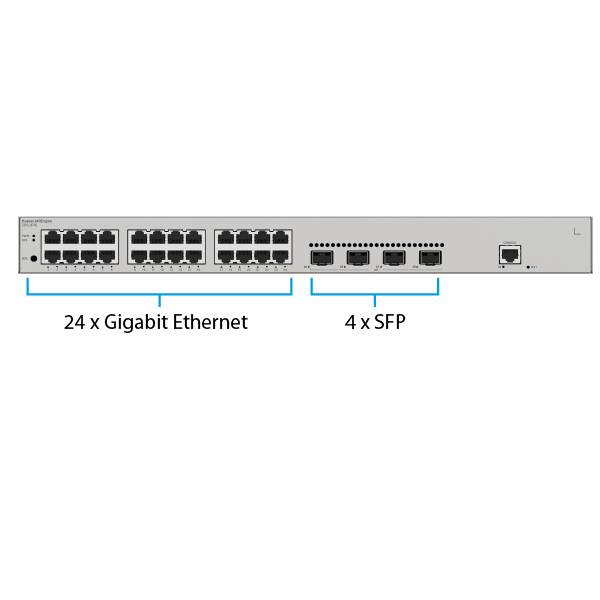
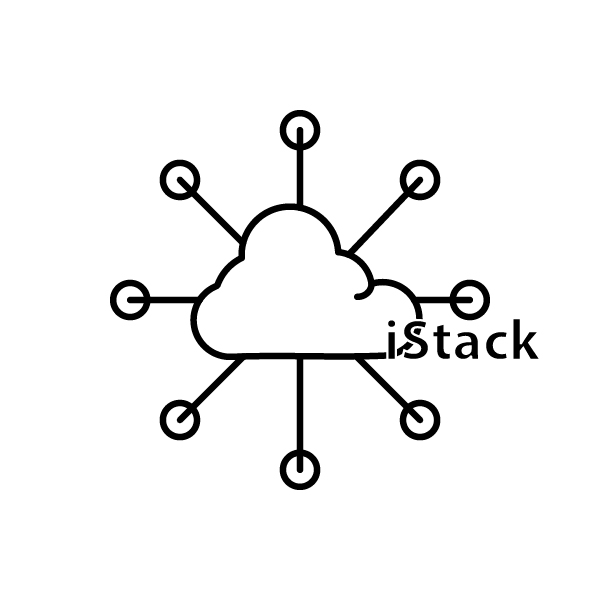
Gestión Layer 2+, iStack
El dispositivo es totalmente compatible con la gestión de Layer 2 y, además, dispone de funciones básicas de Layer 3 como el enrutamiento estático. Admite VLAN, multidifusión (IGMP Snooping, MLD Snooping), funciones QoS y listas de control de acceso (ACL). Soporta los protocolos Spanning Tree (STP / RSTP / MSTP) y el moderno estándar ERPS (Ethernet Ring Protection Switching) definido en IUT-T G.8032.
El switch proporciona una seguridad de red esencial. Protege contra ataques DoS - SYN flood, Land, Smurf e ICMP flood. También tiene protección contra ataques dirigidos al usuario - ataques al servidor DCHP, IP/MAC spoofing, DHCP request flood o DHCP CHADDR.
La serie S310 es compatible con iStack, varios switches pueden apilarse lógicamente en un único switch virtual. Esto simplifica la gestión de la red y permite crear conexiones de respaldo adicionales para protegerse de posibles fallos.
La gestión se realiza desde la GUI web, CLI o mediante SNMP (v1, v2c, v3) / SSH2.0. Los dispositivos de la serie S310 también se pueden gestionar en la nube, en cuyo caso se puede utilizar adicionalmente la app Huawei eKit.
Aplicación
Gracias a su rica gestión, el S310-24T4S es perfecto como switch principal en varios tipos de redes. El uso de 24 puertos le permitirá conectar muchos dispositivos que no requieren alimentación PoE. En redes de oficinas más pequeñas, el S310-24T4S puede servir con éxito como único conmutador.
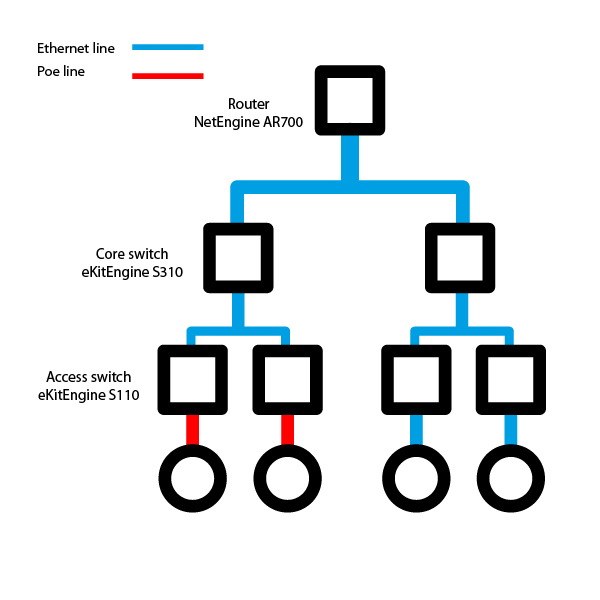
Especificación
| Huawei S310-24T4S | |
| Capacidad de conmutación | 56 Gb/s |
| Velocidad de transmisión de paquetes | 42 Mp/s |
| Puertos |
24x Gigabit Ethernet 10/100/1000 Mb/s 4x SFP (1 Gb/s) |
| Dimensiones | 43.6 mm x 442 mm x 227 mm |
| Altura | 1U |
| Peso | 2,32 kg |
| Método de alimentación | Adaptador de AC incorporado |
| Tensión nominal de entrada | 100 - 240 V AC, 50/60 Hz |
| Rango de tensión de entrada | 90 - 290 V AC, 55/65 Hz |
| Consumo máximo | 34,04 W |
| Volumen |
A temperatura normal: 47 dB (A) A temperatura alta 51 dB (A) |
| Temperatura de funcionamiento admisible | De -5 a 50 grados C |
| Temperatura de almacenamiento admisible | De -40 a 70 grados C |
| Humedad del aire admisible | 5%-95% no condensante |
| Protección contra sobretensión para puertos de servicio | ±10 kV |
| Protección contra sobretensión del puerto de alimentación | ±6 kV |
| Enfriamiento | Ajuste activo e inteligente de las velocidades del ventilador |
| Características del software | |
|---|---|
| Tabla de direcciones MAC |
Aprendizaje / envejecimiento automático de direcciones MAC Máx. 16.000 direcciones MAC Entradas de direcciones MAC estáticas / dinámicas / blackhole Filtrado de direcciones MAC de origen Límite de direcciones MAC almacenadas por interfaz |
| VLAN |
4094 VLANs Voice VLAN MUX VLAN Asignación de VLAN basada en dirección MAC, protocolo, subred IP, política y puertos VLAN stacking |
| Ethernet switching |
Topología Smart Link tree y Smart Link multi-instance G.8032 ERPS (Ethernet Ring Protection Switching) STIP (IEEE 802.1d), RSTP (IEEE 802.1w), MSTP (IEEE 802.1s) BPDU / protección de raíz / contra bucles Túnel BPDU |
| Multicasts | IGMP v1 / v2 / v3, IGMP v1 / v2 / v3 snooping oraz MLD snooping |
| Routing IP |
Enrutamiento estático y PBR (enrutamiento basado en políticas) Hasta 512 FIBv4 Hasta 512 FIBv6 |
| Funciones IPv6 |
ND (neighbor discovery) PMTU IPv6 ping, IPv6 tracert, IPv6 telnet |
| Estabilidad |
LACP (Link Aggregation Control protocol) VRRP (Virtual Router Redundancy Protocol) BFD (Bidirectional Forwarding Detection) LLDP (Link Layer Discovery Protocol) |
| Función QoS / Control de acceso ACL |
Límite de tráfico basado en entrada/salida por puerto Reenvío de paquetes CAR tricolor de dos velocidades, enrutamiento del tráfico basado en el puerto 8 colas por puerto Algoritmos de colas: DBR, SP, DRR+SP Remarcación de prioridades 802.1p y DSCP a paquetes Filtrado de paquetes de Layer 2 - Layer 4, filtrado de tramas erróneas basado en dirección MAC de origen, dirección MAC de destino, dirección IP de origen, dirección IP de destino, número de puerto TCP/UDP de origen/destino, protocolo o VLAN Limitación y modelado del tráfico por puerto Network slicing (VLAN/VXLAN) |
| Seguridad |
Gestión jerárquica de usuarios y protección por contraseña Protección contra ataques DoS, APR e ICMP Asignación de dirección IP, dirección MAC, ID de puerto e ID de VLAN Aislamiento de puertos, seguridad de puertos, MAC pegajosa Autenticación IEEE 802.1X y límite del número de usuarios por interfaz Múltiples métodos de autenticación, incluidos AAA, RADIUS, HWTACACS y NAC SSH v2.0 HTTPS Protección de CPU Lista blanca y lista negra Cliente DHCP, DHCP relay, DHCP servidor, DHCP snooping Cliente DHCPv6, DHCPv6 relay |
| Gestión y mantenimiento de redes |
iStack Gestión de la nube basada en NETCONF/YANG VCT (prueba de cable virtual) Configuración y mantenimiento remotos de la red mediante Telnet SNMP v1/v2/v3 RMON Gestión mediante sistema web HTTPS LLDP/LLDP-MED Registros y alarmas del sistema IEEE 802.3az EEE (Energy Efficent Ethernet) Port mirroring Ampliación de red mediante registration query center |
| Interoperabilidad |
VBST Cooperación con PVST, PVST+ i RPVST |






 Polski
Polski English
English Italiano
Italiano Español
Español Čeština
Čeština Српски
Српски Deutsch
Deutsch Ελληνικά
Ελληνικά Slovenský
Slovenský

